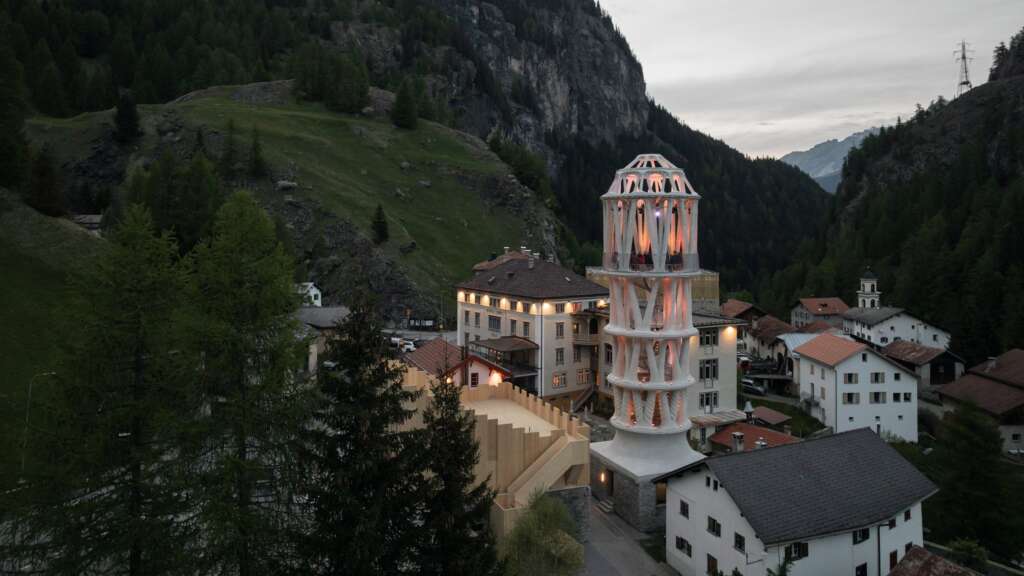Share This Article
Discover Tor Alva: A Mesmerizing Fusion of Digital Craftsmanship, Cultural Memory, and Alpine Ambition
Perched in the sleepy alpine village of Mulegns, where only 11 people call home, a striking new structure has risen that is already making waves in the world of architecture and innovation. Meet Tor Alva, or the White Tower — the world’s tallest 3D-printed tower, standing 30 meters high and made entirely of prefabricated concrete columns, each resembling the intricate layers of a grand celebratory cake.
This isn’t just a feat of engineering. It’s a cultural statement, a beacon for sustainable tourism, and a potential savior for a fading village nestled in the canton of Graubünden.

From Blacksmith’s Shop to Concrete Masterpiece
Unveiled on May 20th, 2025, in a dramatic moment when a helicopter lifted the veil concealing the structure, Tor Alva was revealed in its full ethereal glory. Built on the site of an old blacksmith’s workshop, its ornate, spiraling silhouette now reflects a bold vision for the future — one where digital technology and cultural memory entwine.

The tower, with its layered and laced forms, was designed to evoke the aesthetic of a wedding cake. This design choice isn’t whimsical; it pays homage to the region’s historic confectioners who emigrated from Graubünden to spread their sugary craftsmanship across Europe. That past is now frozen in concrete — but built with the most modern tools imaginable.
The Team Behind the Tower
Commissioned by Nova Fundaziun Origen, a cultural foundation dedicated to revitalizing rural communities through art and performance, Tor Alva is the brainchild of an elite team: architect Michael Hansmeyer and ETH Zurich professors Walter Kaufmann, Robert Flatt, and Benjamin Dillenburger. Their collaboration with ETH Zurich’s Mesh (a spin-off company) and Zindel United, a Swiss construction firm, brought this concept to life.
And the numbers are staggering: the tower was assembled from 3D-printed components over five months at ETH Zurich’s Hönggerberg campus. These elements were then trucked into Mulegns and assembled without a single drop of glue.
How Do You Build a 30-Meter Tower Without Formwork or Cement Glue?
Enter additive manufacturing — the futuristic process of robotic 3D printing. Tor Alva was born layer by precise layer, with one robot delicately applying concrete while another embedded steel ring reinforcements every 20 centimeters. This method not only ensured structural strength but allowed for elegant, lace-like reliefs to form on each column.
The structure relies on removable screws and post-tensioning cables, making it entirely dismountable. In fact, Tor Alva is designed to be taken apart and rebuilt somewhere else in five years — a travelling monument of sorts.
Even the concrete itself is high-tech. ETH Zurich professor Robert Flatt developed a unique mix that hardens rapidly and responds well to robotic printing. As the concrete exits the nozzle, two additives blend in to help the mixture shape into droplet-like textures, lending the columns a sculptural quality usually reserved for hand-carved stone.

More Than a Tower — A Cultural Catalyst
Inside, a spiral staircase winds through four stories, culminating in a domed performance space that will soon host music, theatre, and art events. Starting this Friday, visitors can explore the tower through daily guided tours.
Architect Michael Hansmeyer noted that this is the first time 3D printing has been used for structural—not just decorative—components, marking a significant leap in construction innovation.
But Tor Alva is more than a technical marvel. According to Giovanni Netzer, founder of Nova Fundaziun Origen, it’s “a symbol of hope, of rebirth.” By planting such an audacious structure in a nearly abandoned village, the project aims to spark sustainable tourism, generate global attention, and breathe new life into Mulegns.

A Glimpse into the Future of Construction
Tor Alva joins a new wave of landmark projects proving the power and potential of 3D printing in architecture. From the world’s first 3D-printed railway station in Japan to the soon-to-open 3D-printed Starbucks in Texas, the technology is no longer experimental — it’s transformational.
But perhaps no structure better embodies the poetic possibilities of this new medium than the White Tower. In Mulegns, innovation is not just building upward. It’s reaching backward, drawing from the past, and planting seeds for what’s yet to come.

Planning to Visit?
Tor Alva is open for guided tours daily. Don’t miss the chance to walk inside a monument that may soon be a global icon of architectural evolution.

Source: https://bit.ly/40K4XSM
